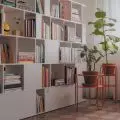Rubra in Latin means red. This color has become the distinguishing feature and leitmotif of the estate of the same name, designed by Pawel Lis of the Paweł Lis Architekci studio. Where did the designer use the title red, and why was it chosen?
One of the features that binds examples of historic buildings in Gdansk Pomerania is the material eagerly used for construction - red brick. It played not only a structural role, in many cases it was also consciously exposed, becoming a marker of local style. Paweł Lis referred to this feature when designing the Rubra estate in Straszyn located a dozen kilometers from the center of Gdansk.
Rubra estate in Straszyn near Gdansk
Photo: Emi Karpowicz © Paweł Lis Architekci
estate near Gdañsk
The design of the Rubra estate was created in 2021. In the course of construction lasting three years, an intimate estate was created, consisting of six semi-detached houses and one detached villa. The buildings were sited on a steep plot with a triangular outline. The layout of the site has judged the cascading arrangement of the individual buildings, which do not obscure each other, providing residents with an adequate amount of light and creating a backdrop composition. The appropriate arrangement of the semi-detached houses and villas also made it possible to have terraces and gardens facing south.
Rubra estate in Straszyn near Gdansk, Poland
Photo: Emi Karpowicz © Paweł Lis Architekci
semi-detached houses and a villa
All buildings are two-story structures. In the case of semi-detached houses, the houses have been optically separated by separating the blocks of the floors - they are sited on a common first floor, but moved a short distance away from each other. The floors have been partially overhung, creating arcades at the entrance areas and at the rear of the buildings. The detached villa, located at the southeastern end of the plot, has a slightly different structure. In this case, the architect opted for a horizontal layout, in which the monolithic mass of the first floor is dissected by a ribbon-shaped, slotted window.
Rubra estate in Straszyn near Gdansk, Poland
Photo: Emi Karpowicz © Paweł Lis Architekci
The devil is in the details
The lumps of the buildings, although relatively simple, were derived from the architectural tradition of the region. The lead designer, Pawel Lis, points to several sources of inspiration. The numerous bevels used, both in the canopies and in the walls themselves, are meant to refer to the braces in traditional timber frame architecture, where they serve the function of reinforcing the roof truss structure. The spaces under the overhanging blocks of the floors, in turn, are inspired by the type of arcaded house typical of Gdansk Pomerania.
Rubra estate in Straszyn near Gdansk, Poland
Photo: Emi Karpowicz © Paweł Lis Architekci
estate in red
The most striking element of the Rubra estate's architecture, however, is the way the facade is finished. The houses are covered with red veneer, made of clinker tiles. The reference to the architecture of the region is obvious here - among the most prominent examples are the Teutonic Castle in Malbork, but also a significant part of the historic buildings of Gdansk, including the Great Armory, Gdansk City Hall and Artus Court. Brick is also eagerly used by designers of contemporary Gdansk architecture, as exemplified by the Riverview housing estate located on the Motława River.
Rubra estate in Straszyn near Gdansk, Poland
Photo: Emi Karpowicz © Pawel Lis Architekci
Pawel Lis points to closer chronologically and geographically closer inspirations - 19th- and 20th-century buildings in nearby Pruszcz Gdanski, including an old mill, sugar factory, remains of railroad stations or tenement houses. Buildings of hydroelectric power plants, located on the nearby Radunia River, were to be an important model. Between Straszyn and Pruszcz Gdański, five hydroelectric power plants were built in the early 20th century, with buildings erected in historicizing forms. Three of them were covered with red brick, typical of the region.
Rubra estate in Straszyn near Gdansk
Photo: Emi Karpowicz © Paweł Lis Architekci
However, for the exterior walls of the Rubra estate's buildings, the architects abandoned the use of full-size bricks, the size of which would significantly affect the area occupied by the houses. Instead, the facades at the Rubra estate were finished with clinker tiles, which were created by cutting the bricks by hand, varnishing them and then firing them in a kiln. The reinterpretation of tradition in this case is the vertical arrangement of the clinkers.
Rubra estate in Straszyn near Gdansk, Poland
Photo: Emi Karpowicz © Paweł Lis Architekci
estate in the green
The Rubra estate is located in a picturesque area near Straszyn Lake and the Radunia River. The immediate surroundings, in addition to a relatively favorable location in terms of communication, abound in charming views, walking paths and recreational activities - canoeing down the Radunia River or walking along the trail of 20th-century hydroelectric power plants. The plot itself is also surrounded by greenery, as it is bordered on the southern side by a wooded slope. Due to the irregular layout of the site, each of the houses has an individually designed garden, while in the case of the detached villa closest to the escarpment, a terrace suspended above the cliff has been developed. Under the circumstances, the very meticulous concreting of the immediate surroundings of the houses on the north side is somewhat surprising.
Rubra estate in Straszyn near Gdansk, Poland
Photo: Emi Karpowicz © Paweł Lis Architekci
The Rubra Estate is yet another residential complex in Straszyn, created through the cooperation of Herzinvest and Pawel Lis. The small-scale buildings are aptly inscribed in a triangular plot, creating a fairly compact development quarter. The houses have diverse layouts and masses, yet present a coherent aesthetic concept - will the brick facades stand the test of time, as well as the historic buildings of the region?



































































